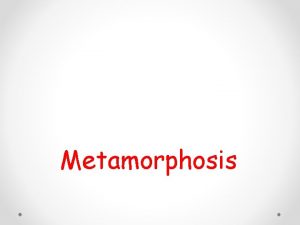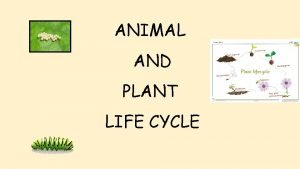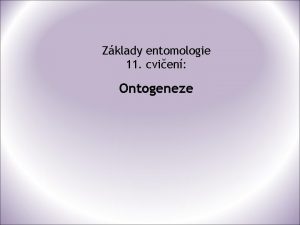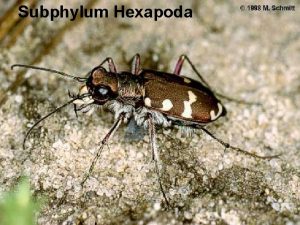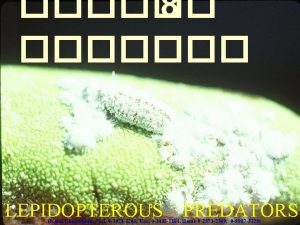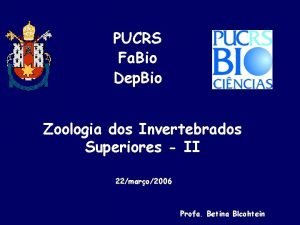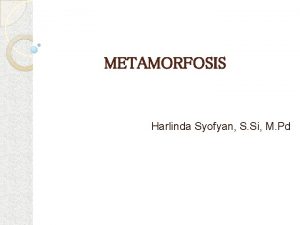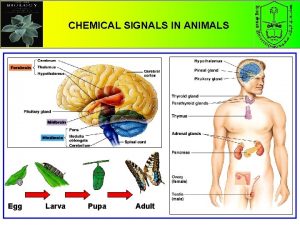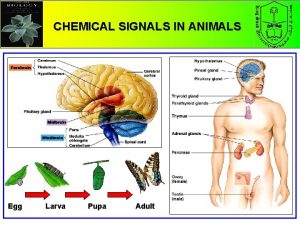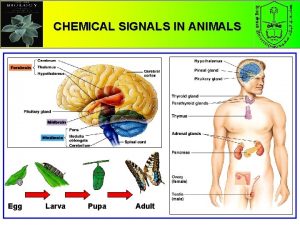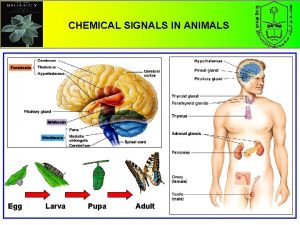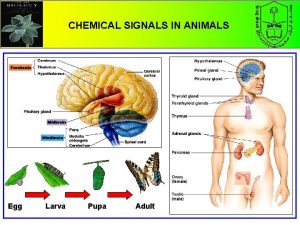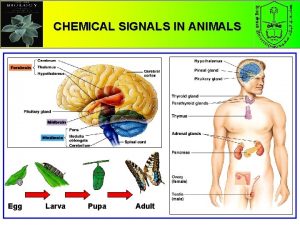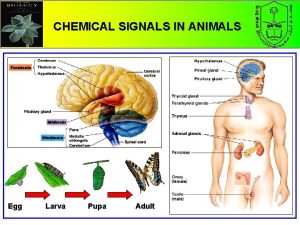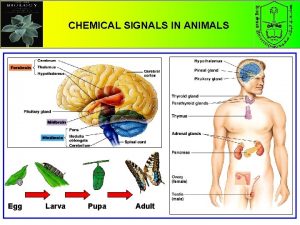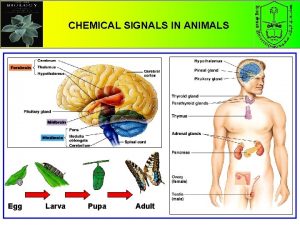CHEMICAL SIGNALS IN ANIMALS Egg Larva Pupa Adult














- Slides: 14

CHEMICAL SIGNALS IN ANIMALS Egg Larva Pupa Adult 1

Function and Secretion • Hormones are substances secreted by cells that act to regulate the activity of other cells in the body. – Hormones affect all cells in the body and are made and secreted by endocrine glands. • Endocrine glands are ductless organs that secret hormones either into the bloodstream or the fluid around cells. • The endocrine glands can be found through out the body and are collectively known as the endocrine system. • Endocrine glands, such as the pancreas, can also be exocrine glands. – Exocrine glands secrete substances through ducts to specific locations inside and outside the body.

• Nervous and endocrine systems are the main internal communication and regulation systems. • The animal hormone-secreting cells constitute the endocrine system. • Hormone secreting organs are called Endocrine Glands (ductless glands ) ﺍﻟﻐﺪﺩ ﺍﻟﺼﻤﺎﺀ. While Exocrine Glands secrete substances through ducts to specific locations inside and outside the body. • Hormone is a chemical signal secreted into blood stream and regulates communicating messages within the body. • Target cell is the site that is reached by the hormone to which it responds. • Complete changes in the body is regulated by hormones (e. g. metamorphosis in insects). • Types of hormones are [Polypeptide H. , Amino acid derivatives H or Steroid H. ].

Types of Hormones and Mechanism of chemical signaling: Hormones can be grouped into two types based on their structure. Hormones can either be amino acid-based hormones or steroid hormones. – Amino acid based-hormones (protein hormones) are made of amino acids, either a single modified amino acid or a protein made of 3 -200 amino acids, and are water soluble. – Steroid hormones are lipid hormones that body makes from cholesterol and are fat soluble. • Similar to steroid hormones are thyroid hormones. I): Protein hormones: Bind to a receptor protein on the surface of the target cell which will trigger signal transduction pathway. 4

II) Steroid hormones: Penetrate the cell and bind to a receptor protein inside the target cell. This also will trigger signal transduction pathway (for triggering m. RNA transcription for synthesizing a specific protein). • Estrogen, progesterone, vitamin D and NO. – Usually, the intracellular receptor activated by a hormone is a transcription factor. 5

• Tropic hormones: ( ﺍﻟﻬﺮﻣﻮﻧﺎﺕ ﺍﻟﻤﺤﻔﺰﺓ )ﺍﻟﻤﻨﺒﻬﺔ Target other endocrine glands and are important to understanding chemical coordination. • Many endocrine organs contain specialized nerve cells called neurosecretory cells that secret hormones. • The hormone epinephrine has two functions: – As a hormone of the endocrine system. – As a signal in the nervous system. • Feedback is common in regulation of the activity of both endocrine and nervous systems (homeostasis): – Calcitonin and parathyroid hormones play an important role in maintaining the concentration of the blood calcium constant. – They are secreted from thyroid and parathyroid glands respectively. • Hormones regulate the development of invertebrates (e. g. insects) 6

The Vertebrate Endocrine System · Tropic hormones ( )ﺍﻟﻬﺮﻣﻮﻥ ﺍﻟﻤﻨﺒﻪ ﻟﻠﻐﺪﺩ other endocrine glands and are important to understanding chemical coordination. ﺍﻟﺼﻨﻮﺑﺮﻳﺔ ﺍﻟﻨﺨﺎﻣﻴﺔ ﺍﻟﺪﺭﻗﻴﺔ · Target ﺍﻟﻜﻈﺮﻳﺔ • Human has 9 endocrine glands. 7 Fig. 45. 5, Page 960

The hypothalamus and pituitary integrate many functions of the vertebrate endocrine system The hypothalamus and the pituitary gland, control the initial release of many hormones for the endocrine system. v v v The hypothalamus is the area of the brain that coordinates many activities of the nervous and endocrine systems. The pituitary gland has two parts, anterior and posterior, and stores and releases hormones produced by the hypothalamus Neurosecretory cells of the hypothalamus produce hormones. a) Releasing hormones stimulate the anterior pituitary (adenohypophysis) to secrete hormones. b) Inhibiting hormones prevent the anterior pituitary from secreting hormones. Hypothalamus Posterior pituitary Anterior pituitary

1)- Pituitary gland: Secrets 9 hormones ( 7 hormones by the anterior part and 2 hormones by the posterior part). A)- Anterior pituitary hormones. 1) Growth hormone (GH): a protein. • • • 2) Stimulates growth and metabolism. Secretion is regulated by hypothalamic hormones. Acts directly on tissues or acts via growth factors. Gigantism: ﺍﻟﻌﻤﻠﻘﺔ excessive GH during development. Acromegaly: excessive GH production during adulthood. Hypopituitary dwarfism ﺍﻟﻘﺰﻣﻴﺔ : childhood GH deficiency. Prolactin (PRL): a protein. • 3) Stimulates milk production and secretion from mammary gland ﺍﻟﻐﺪﺩ ﺍﻟﻠﺒﻨﻴﺔ. This secretion is regulated by hypothalamic hormones. Gonadotropins (Gonotropic )ﻣﺤﻔﺰ ﻟﻠﻤﻨﺎﺳﻞ : glyocoproteins. • Follicle-stimulating hormone (FSH). – – Stimulates production of sperms and ova. Secretion is regulated by hypothalamic hormones. 1) Luteinizing hormone (LH) ﺍﻷﺼﻔﺮ ﺍﻟﺣﻔﺰ ﻟﺘﻜﻮﻳﻦ ﺍﻟﺠﺴﻢ – Stimulates ovaries and testes. – Secretion is regulated by hypothalamic hormones. .

4) Thyroid-stimulating hormone (TSH): a glycoprotein. • • • 5) Stimulates thyroid gland. Secretion is regulated by thyroxine in blood. Secretion is also regulated by hypothalamic hormones. Adrenocorticotropic hormone (ACTH): a peptide • • 6) Stimulates adrenal cortex secretion of glucocorticoids Secretion is regulated by glucocorticoids and hypothalamic hormones. Melanocyte-stimulating hormone (MSH): a peptide. • 7) May play a role in fat metabolism. Endorphins: peptides. • • Inhibit pain perception. Effects mimicked by heroin and other opiate drugs. 10

The anterior pituitary gland hormones Melanocytestimulating H. Adrenocorticotropic Also called gonadotropin hormones ﻫﺮﻣﻮﻧﺎﺕ ﺍﻟﻤﻨﺎﺳﻞ 11

B)- Posterior pituitary hormones. – Oxytocin: a peptide. • Stimulates contraction of the uterus and mammary glands. • Secretion is regulated by the nervous system. – Antidiuretic hormone (ADH): ﻹﺩﺭﺍﺭ ﺍﻟﺒﻮﻝ ﺿﺎﺩ a peptide. • Promotes retention of water by the kidneys (in Kidney tubules). • High level decreases urination and vice versa. • Secretion regulated by water/salt balance. Antidiuretic H 12

Summary of Hormones Secreted by the Pituitary Gland

2 - Pineal gland: ﺍﻟﻐﺪﺓ ﺍﻟﺼﻨﻮﺑﺮﻳﺔ It is a small mass of tissue near the center of the mammalian brain and is involved in biorhythms. – The pineal gland secretes the hormone, melatonin, an amine. • Involved in biological rhythms associated with reproduction. • Secretion is regulated by light/dark cycles. Pineal gland Pituitary hormones
 Metamorphosis what is it
Metamorphosis what is it Sterngrr
Sterngrr Egg larva pupa adult
Egg larva pupa adult Communicative signals and informative signals
Communicative signals and informative signals Difference between communicative and informative signals
Difference between communicative and informative signals Communicative signals and informative signals
Communicative signals and informative signals Pupa dectica
Pupa dectica Pupa salms un ogle
Pupa salms un ogle холометаболно
холометаболно Epius pupa
Epius pupa Curculioniforme
Curculioniforme Pupa coarctada
Pupa coarctada Telur culex
Telur culex Tujuan metamorfosis
Tujuan metamorfosis Pupa bsc
Pupa bsc
